One the basic tenets in my book Plant Whatever Brings You Joy is “Never pull up and discard what you cannot identify.” So when a soft grey-green plant emerged in the side garden, sporting a lovely green rosette, I was not inclined to pull it. I was more interested in identifying it, and exploring what it had to offer. And somewhere inside myself was an old memory that this was a plant I’d seen before. Hmmm. A brief description to an old friend of mine on the Cape brought the memory to the fore. It was mullein. Now what the heck is mullein and what is it doing here? What does it have to offer and to teach me? Let’s explore!
“To know a plant you must work with the plant.” ~Kathryn Hall
I turned first to well-worn reference books that have served me over the years as starting points, Back to Eden by Jethro Kloss, which every self-respecting back-to-the-land woman owned in the 60’s. Then, of course, there is Culpeper’s Complete Herbal, the work of Britain’s Nicholas Culpeper (1616-1654). For a modern interpretation I refer again to Practical Herbs by Henriette Kress of Finland, recently here reviewed. I rounded out my research through google readings and a trip to the health food store to purchase a small quantity of mullein (Verbascum thapsus).
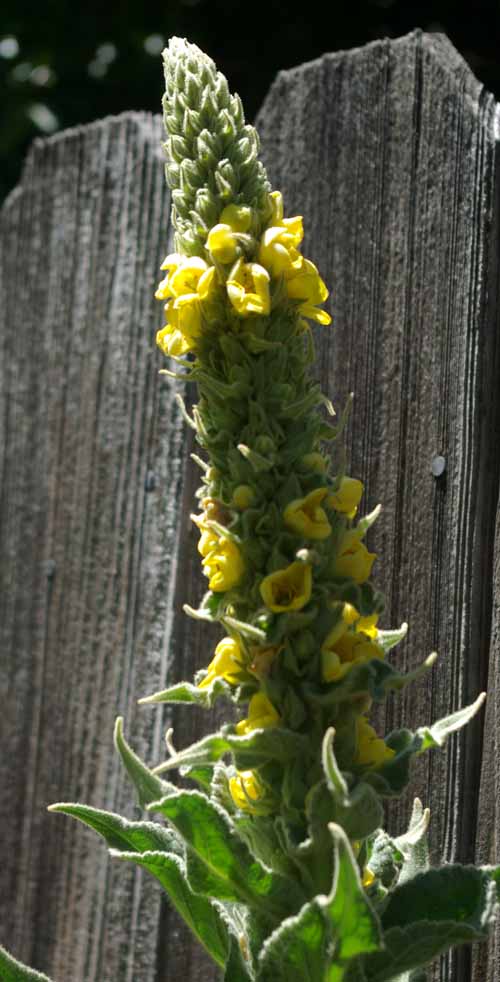
Interestingly Culpepper describes two other varieties of mullein, Verbascum Nigrum (Black Mullein) and Verbascum Lychnitis (White Mullein), so this was not a good resource, other than to know that in the 17th Century the British were also exploring the virtues of mullein! Back to Eden, published originally in 1939 in Tennessee, does address Verbascum thapsus, and begins by describing its various common names, which include velvet plant, white mullein, blanket herb, flannel flower, and hare’s beard. Any of those familiar in your locale? It is not surprising to find the names alluding to the soft leaves of the mullein. They are most attractive. Back to Eden reflects the most common use of mullein I could find–that as a relief for coughs, for lung problems, asthma, croup, bronchitis. I’ve decided this will be my focus, to experiment with the tea for coughs as they emerge during certain seasons. My intuition tells me this is a good remedy to know. As with all herbal use one must do due diligence in researching many sources, and check for any contraindications.
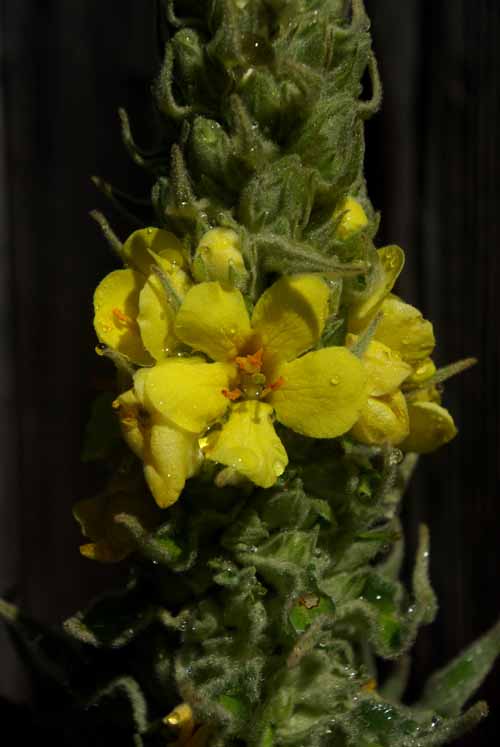
Moving into the 21st Century, Kress focuses on the flowers of mullein, counseling to pick the single flowers, which you dry in a shady spot indoors for a week to ten days, or until very dry. She then instructs us to store them in an airtight glass jar in a dark cupboard and use within a year or so. And how does she use them? She goes on with a recipe for mullein ear oil, saying mullein “reduces both inflammation and pain,”, reassuring that mullein is nontoxic. Encouraged by her work I’m going to take a page from her book on gathering and drying leaves, so I will have my own store of herbs at hand. Always better, don’t you think?
Although I saw one or two references to mullein possibly being “invasive” [the dreaded “I” word] my reading and observations tell me otherwise. There are two other plants in this large garden. One little one, which I may or may not keep, and one rather artfully tucked into a very large buddleia, keeping watch over the myriad butterflies attracted to the just emerged purple blossoms. I like it and it will stay. I treasure the herbs growing here, that I always have access to: spearmint, oregano, rosemary, peppermint, lemon balm and more. To know they are at hand when needed is a blessing for which I am deeply grateful. I hope you also have an abundance of herbs at your ready.
Love and garden blessings,
Kathryn xoxo
Book News: OdeWire has graciously run an excerpt from Plant Whatever Brings You Joy. And, I continue to play with my iPhone’s new feature–that of being able to take pics of oneself, in this case, still enjoying my new hat!
If you’ve not visited the trailer for Plant Whatever Brings You Joy yet, click here!
Posted on June 12th, 2012 by Kathryn
Filed under: Plants
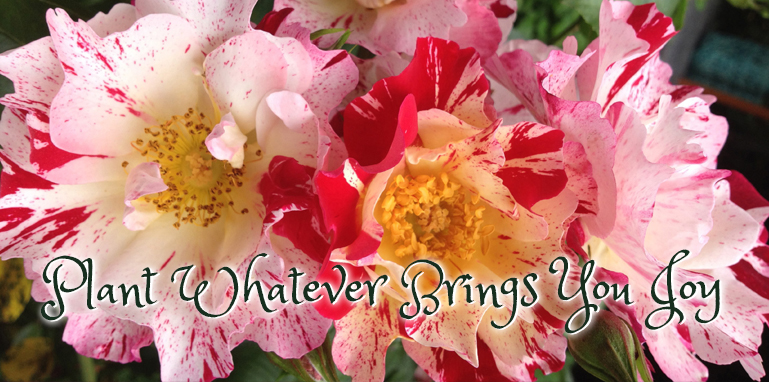



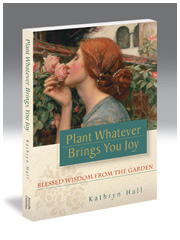




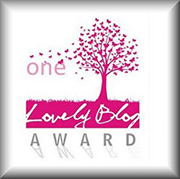
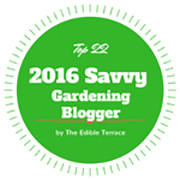

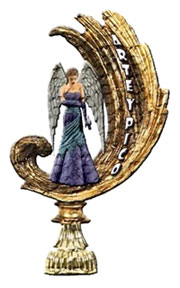
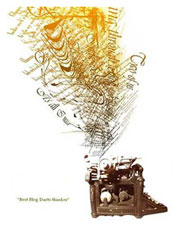
” as a relief for coughs, for lung problems, asthma, croup, bronchitis. ” I was told many years ago that the leaves were dried and then smoked in a pipe for those purposes by Native Americans. One form of mullein grows in abundance along rairoad tracks in Pennsylvania.
One of my most favorite “Wayside herbs”. I had a dried mullen stalk in a crock in my entryway for years, just to enjoy it’s strong shape. Here in our yard we have two mullens, the Giant Mullen which you are showing and a smaller Moth mullen which may be native or may have come from a packet of “bees & butterfly” seeds. They are both biannual and seed in the most unexpected places. We always leave them be unless they are in the middle of grass, of which we have very little. We see them growing in disturbed ground with Queen Anne’s lace and blue chickery in mid-summer in the mid-west. The white, blue and spikes of yellow are just a joy on the landscape. You have new uses the I did not know about. The one I know is to use the leaves, either fresh or dried, to cover wounds that have been well scrubbed (don’t use mullen leaves collected along roadsides for this as they may be contaminated with air pollutants from the traffic, also true for rose hips and black berries and other brambles). I’m so glad they grow in California! Here in Ohio we are just about past all the roses and into daylilies, somewhere between 2-4 weeks ahead of schedule. Also very dry after last year’s wettest year on record.
Sue has been bringing plastic milk crates home from work which we have been “repurposing” all over the place. Our most inspired reuse yet is to line one with cardboard & fill with potting soil to make a great planter for patios, etc. We are filling them with flowers this year but see a super use for “1-foot” gardening projects for the vegetable garden as well. She gets red & black ones and the red are really cheery. So much better than sending them to a landfill.
Hugs, Cousin Julie
Hi, Dick, That’s interesting! One of the notes in Back to Eden was suggesting inhaling the smoke from the burned root for asthma! Must be something there to explore. Thanks for sharing! Kathryn xoxo
Hi, Julie, Wow. Love that you know this plant and one of its uses. The more I hear the more I think this is an invaluable herb we should know about and employ. It’s so sad when we lose the thread on these gifts all around us. I feel so blessed to learn about them and bring them into my kitchen and healing life. I don’t know what I’d do without chamomile, for instance. I think mullein is going to move up into that category in this household.
Love the crate idea! Kathryn xoxo
Hi mom,
Thanks for the introduction to mullein. And, for reiterating the importance of herb usages; they offer so much.
Love you,
Antonia
xoxo
Good morning, Antonia! Happy to pass along my plant learnings. So glad I have a daughter who turns to herbs when needed! God bless the herbs. Love, Mom xoxo
I have two blooming right now in the yard. I collected some seeds last year from an herb garden next to the library downtown and planted them and up they came. Beacuse they primarily bloom in cool weather or at night I think that’s why they must be called Moth Mullein. The cool June weather along California’s coast is perfect for my plants. Colorful. Striking yellow flowers.
Hi, Dave, So happy to hear others are enjoying mullein in their gardens! Good for you for being a seed collector! Kathryn xoxo
Not sure whether to share this…oh well…here goes. Quite by accident I discovered today that, during the Middle Ages, mullein leaves were used as toilet wipes.
Hi, Dick! LOL! Well, undoubtedly they were the softest thing around! Thanks for sharing! Kathryn xoxo
Mullein are great. We have them growing all over our acreage and the birds love them. I don’t know why some people think they are less than great!
[…] Plant Whatever Brings You Joy » The Virtues of Mullein […]
Welcome, sensiblegardening! Yes, I agree! I know a big fat bumblebee who had his satchels full of pollen this morning climbing around my mullein flowers who would also agree with you wholeheartedly! Kathryn xoxo
I had no idea what this plant was ( – two of them, actually, side by side) when they appeared in my garden in Porthcawl (S.Wales) last autumn.
Reluctant to dig them up and throw them away, I decided to let them grow and see what developed. Delighted that I did! Two very tall, healthy plants with masses of yellow flower spikes. Beginning to die back now … let’s see what happens next!
(Does anyone have any idea how they may have found their way into my garden? How common is this plant?)
Hi, Alan, and welcome! Yes, we have the same curiosity about plants that just show up. I have a total of three now. Not very invasive at this point. One is little. One is huge (and arching–I like it). Yes, let’s see what happens next! Happy to know you have them in S. Wales! Kathryn xoxo